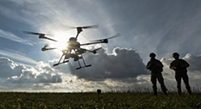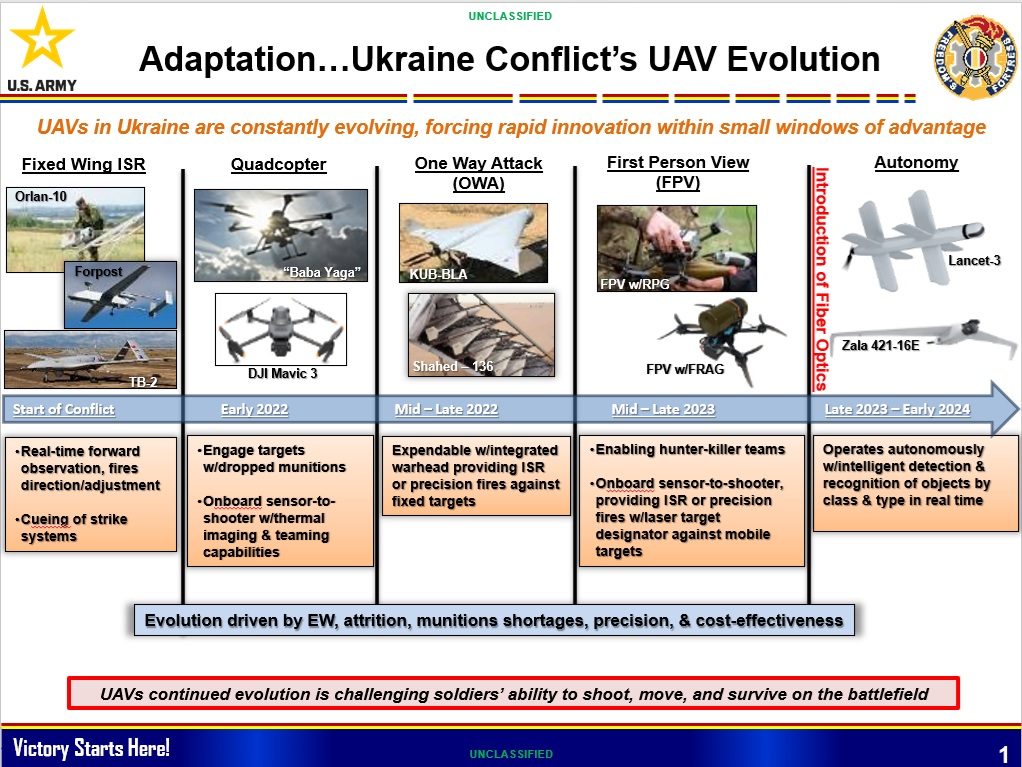[Editor’s Note: The Mad Scientist Laboratory welcomes back returning guest blogger and proclaimed Mad Scientist Steve Pomper with today’s submission addressing how the U.S. can achieve what Defense Secretary Pete Hegseth announced in his Unleashing U.S. Military Drone Dominance initiative on 10 July 2025:

“Lethality will not be hindered by self-imposed restrictions, especially when it comes to harnessing technologies we invented but were slow to pursue. Drone technology is advancing so rapidly, our major risk is risk-avoidance. The Department’s bureaucratic gloves are coming off.“
Mr. Pomper proposes to crowdsource the Nation’s enormous potential pool of autonomous innovation — including 3D printing enthusiasts, hobbyists, small- to medium-sized businesses, as well as our junior Soldiers and Leaders — enabling the Department of Defense to rapidly pivot and begin acquiring, training with, and expending small Unmanned Aerial Systems (sUAS) by the millions — achieving a scale just like any other type of CLASS V munition. By harnessing this whole-of-nation approach, our Joint Force can build both its proficiency with these revolutionary capabilities and rapidly acquire the requisite magazine depth to match similar modernization efforts currently underway in both China and Russia. Read on to learn how this crowdsourcing approach could help transform and rapidly scale tomorrow’s battlefield autonomy-enabled force!]
“It was 2 a.m. and I was on watch. I didn’t even hear it come in—it just hit the ground. A blinding flash of light, and then I’m on my back. When I came to, I thought my mates were probably gone. Fortunately, we all survived. Absolute miracle.” 1
If you follow defense-related news, you’ve likely noticed increasing concern about the U.S. “defense industrial base” and its limited “magazine depth.” As Army Secretary Driscoll recently stated, “We are going to expand the defense industrial base and who we purchase from…”2 The underlying issue isn’t just about quantities or costs—it’s the historically sluggish acquisition process.
 This thought-paper proposes a novel approach to rapidly acquire large quantities of relatively simple but effective systems—specifically small unmanned aircraft systems (sUAS)—so that we don’t have to rely on miracles. While sUAS are the current priority, this approach could be expanded to include other technologies as innovation progresses.
This thought-paper proposes a novel approach to rapidly acquire large quantities of relatively simple but effective systems—specifically small unmanned aircraft systems (sUAS)—so that we don’t have to rely on miracles. While sUAS are the current priority, this approach could be expanded to include other technologies as innovation progresses.
The acquisition community often gets a bad rap, but it has delivered in times of need—though the bench is shallow if you want a new submarine or tank. However, times are changing. Fueled by both technological advancement and wartime necessity, innovation is evolving faster than ever. The Russia-Ukraine war serves as a deadly proving ground, highlighting both novel systems and the resurgence of older tactics like decoy deception.

Right now, we do not have enough sUAS to train with—let alone go to war. While industry is producing and units are fabricating, output is a trickle compared to the flood needed for a major conflict. Yet we are gaining valuable experience with the limited systems available, and rapid improvements are constantly emerging. Secretary Driscoll remarked, “Russia has manufactured one million drones in the last 12 months.”3 Impressive—unless they’re obsolete. This is a good lesson for the Army, but at some crisis point, you simply need it now.
So, how do you get millions of drones, fast?
You crowdsource it.
Across the country, thousands of 3D printing enthusiasts, hobbyists, and small- to medium-sized businesses already have the tools and skills needed. In a crisis, the Army could distribute the latest design files and let the printing begin. Not all tools print in plastic—some use routers to carve materials like wood, metal, or plastic; others use lasers. With minimal quality control, many of these tools can produce parts with sufficient precision. Knowing the capabilities and limitations of different tools would be essential.
But why would people volunteer?
 For the same reason Americans collected metal and rags during World War II. They planted victory gardens—not because of food shortages, but because it made them feel part of the war effort. Similarly, volunteers today could contribute to national defense from their garages. Eventually, the Army could provide purpose-made materials, cover shipping costs (or establish drop-off locations at recruiting stations, ROTC units, etc.), and even offer modest compensation. While this is clearly a “break glass” scenario, waiting for the crisis wastes time and opportunity.
For the same reason Americans collected metal and rags during World War II. They planted victory gardens—not because of food shortages, but because it made them feel part of the war effort. Similarly, volunteers today could contribute to national defense from their garages. Eventually, the Army could provide purpose-made materials, cover shipping costs (or establish drop-off locations at recruiting stations, ROTC units, etc.), and even offer modest compensation. While this is clearly a “break glass” scenario, waiting for the crisis wastes time and opportunity.
Learn from Ukraine—start now.
This idea borrows from Ukraine’s example, but with one key difference: we begin before the crisis hits. The Army could incubate a nationwide manufacturing base through a small, cost-effective initiative: a three- to four-person Office of Civilian Drones (OCD) staffed by junior Soldiers who are drone pilots and hobbyists. They would connect with volunteers online, tapping into communities that already exist (e.g., dronepilots.community).4
 Through OCD, plans could be shared, regional contests organized (possibly on military installations—imagine the draw for a 14-year-old!), and prizes awarded. Even a simple certificate—Drone Army Volunteer (DAV)—could go a long way. A tiered system (Novice, Intermediate, Master DAV) and a commemorative coin could further incentivize involvement.
Through OCD, plans could be shared, regional contests organized (possibly on military installations—imagine the draw for a 14-year-old!), and prizes awarded. Even a simple certificate—Drone Army Volunteer (DAV)—could go a long way. A tiered system (Novice, Intermediate, Master DAV) and a commemorative coin could further incentivize involvement.
Just like the levels of war, the OCD initiative would have strategic value by accelerating sUAS production in a crisis. Operational coordination could be handled at the installation level, perhaps as a secondary duty. But the real payoff is tactical—building relationships between Soldiers and DAVs. These technical interactions might even boost recruiting.
More than drones
 This concept could expand into other areas, particularly robotics. The remote-control car and robot-building communities offer expertise in motors, gears, arms, and control systems. Imagine a rabbit-looking surveillance robot that doubles as a munition delivery system. The possibilities are endless.
This concept could expand into other areas, particularly robotics. The remote-control car and robot-building communities offer expertise in motors, gears, arms, and control systems. Imagine a rabbit-looking surveillance robot that doubles as a munition delivery system. The possibilities are endless.
If you enjoyed this post, check out the TRADOC Pamphlet 525-92, The Operational Environment 2024-2034: Large-Scale Combat Operations
Explore the TRADOC G-2‘s Operational Environment Enterprise web page, brimming with authoritative information on the Operational Environment and how our adversaries fight, including:
Our China Landing Zone, full of information regarding our pacing challenge, including ATP 7-100.3, Chinese Tactics, How China Fights in Large-Scale Combat Operations, BiteSize China weekly topics, and the People’s Liberation Army Ground Forces Quick Reference Guide.
Our Russia Landing Zone, including How Russia Fights in Large-Scale Combat Operations and the BiteSize Russia weekly topics. If you have a CAC, you’ll be especially interested in reviewing our weekly RUS-UKR Conflict Running Estimates and associated Narratives, capturing what we learned about the contemporary Russian way of war in Ukraine over the past two years and the ramifications for U.S. Army modernization across DOTMLPF-P.
Our Iran Landing Zone, including the Iran Quick Reference Guide and the Iran Passive Defense Manual (both require a CAC to access).
Our North Korea Landing Zone, including Resources for Studying North Korea, Instruments of Chinese Military Influence in North Korea, and Instruments of Russian Military Influence in North Korea.
Our Irregular Threats Landing Zone, including TC 7-100.3, Irregular Opposing Forces, and ATP 3-37.2, Antiterrorism (requires a CAC to access).
Our Running Estimates SharePoint site (also requires a CAC to access) — documenting what we’re learning about the evolving OE. Contains our monthly OE Running Estimates, associated Narratives, and the quarterly OE Assessment TRADOC Intelligence Posts (TIPs).
Read Steve Pomper‘s previous Mad Scientist Laboratory submission:
OASIS: A North American Proving Ground
Then review the following related content:
Adaptation… Ukraine Conflict’s UAV Evolution, by Colin Christopher
Expendable Drones: Appreciating the Evolving Technology – and Character – of War by proclaimed Mad Scientist Dr. James Giordano, Elise Annett, and John Bitterman
Do Androids Dream of Electric War: The Reality of Autonomous Weapons and associated podcast, with Dr. Mark Bailey
On the Ground and In the Air in Ukraine, and associated podcast with Wolfgang Hagarty
Insights from Ukraine on the Operational Environment and the Changing Character of Warfare
Learning from LSCO: Applying Lessons to Irregular Conflict, by Ian Sullivan and Kate Kilgore
Asymmetric Warfare across Multiple Domains, by Ethan Sah
“Own the Night,” as well as Former Deputy Secretary of Defense and proclaimed Mad Scientist Mr. Bob Work‘s presentation from the Disruption and the Future Operational Environment Conference on AI and Future Warfare: The Rise of the Robots (and Army Futures Command), and his Modern War Institute podcast assessing the future battlefield.
Unmanned Capabilities in Today’s Battlespace
Revolutionizing 21st Century Warfighting: UAVs and C-UAS
Death From Above! The Evolution of sUAS Technology and associated podcast, with COL Bill Edwards (USA-Ret.)
The Operational Environment’s Increased Lethality
Top Attack: Lessons Learned from the Second Nagorno-Karabakh War and associated podcast, with proclaimed Mad Scientist COL John Antal (USA-Ret.)
Jomini’s Revenge: Mass Strikes Back! by proclaimed Mad Scientist Zachery Tyson Brown
Insights from the Robotics and Autonomy Series of Virtual Events, as well as all of the associated webinar content (presenter biographies, slide decks, and notes) and associated videos
Through Soldiers’ Eyes: The Future of Ground Combat and its associated podcast
The PLA and UAVs – Automating the Battlefield and Enhancing Training
A Chinese Perspective on Future Urban Unmanned Operations
China: “New Concepts” in Unmanned Combat and Cyber and Electronic Warfare
The PLA: Close Combat in the Information Age and the “Blade of Victory”
Disclaimer: The views expressed in this blog post do not necessarily reflect those of the U.S. Department of Defense, Department of the Army, Army Futures Command (AFC), or Training and Doctrine Command (TRADOC).
About the Author: Steve Pomper is a retired Cavalryman and now a Department of the Army Civilian at the U.S. Army Test and Evaluation Command (ATEC), Aberdeen Proving Ground, MD. He holds a doctorate in business from the University of South Florida.
1 https://www.rnz.co.nz/news/in-depth/547496/nightmare-fuel-kiwi-soldier-in-ukraine-on-the-reality-of-drone-warfare
2 https://warontherocks.com/2025/05/the-armys-upcoming-transformation-with-secretary-driscoll-and-gen-george/
3 Ibid
4 The Facebook page alone has 45,000 members, https://www.facebook.com/groups/TheDroneCommunity/



